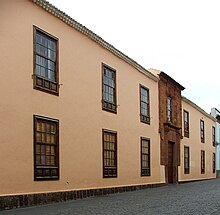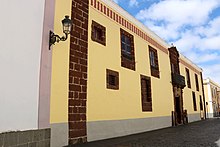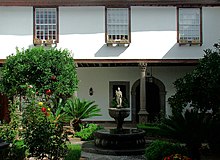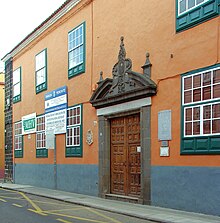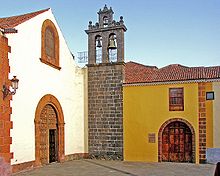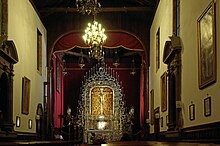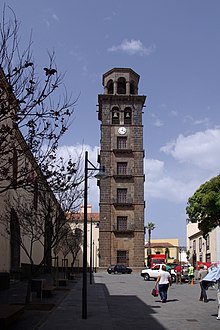San Cristóbal de La Laguna
| San Cristóbal de La Laguna | ||
|---|---|---|
| coat of arms | Map of the Canary Islands | |

|
|
|
| Basic data | ||
| Autonomous Community : |
|
|
| Province : | Santa Cruz de Tenerife | |
| Island: | Tenerife | |
| Coordinates | 28 ° 29 ′ N , 16 ° 19 ′ W | |
| Height : | 546 msnm | |
| Area : | 102.06 km² | |
| Residents : | 157.503 (Jan 1, 2019) | |
| Population density : | 1,543.24 inhabitants / km² | |
| Founding: | 1496 | |
| Postal code : | 38200-38299 | |
| Municipality number ( INE ): | 38023 | |
| administration | ||
| Mayor : | Fernando Clavijo Batlle (CC) | |
| Address of the municipal administration: | C / Obispo Rey Redondo, 1 38201 La Laguna |
|
| Website : | www.aytolalaguna.com | |
| Location of the city | ||
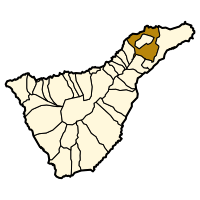 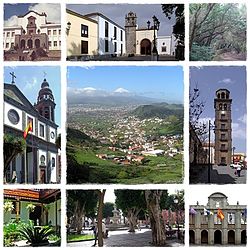
|
||
The city of La Laguna , officially San Cristóbal de La Laguna , is a university town (25,000 students) and a bishopric with 157,503 inhabitants (as of January 1, 2019) on the Canary Island of Tenerife .
Location and climate
La Laguna is located west of Santa Cruz de Tenerife . The suburbs of La Laguna and Santa Cruz de Tenerife flow into one another. Neighboring municipalities are Santa Cruz de Tenerife in the east, El Rosario in the south and Tacoronte in the southwest and the as enclave enclosed Tegueste . The administrative area of the city also includes some tourist areas on the north coast of the island such as Bajamar and Punta del Hidalgo . The municipality of San Cristóbal de La Laguna has an area of 102.06 km². Downtown La Laguna is located at an altitude of about 550 m above sea level.
Due to its altitude at 550 meters above sea level, the weather is on average 4 degrees cooler than in neighboring Santa Cruz de Tenerife . The weather is characterized by the northeast trade winds, which bring evenly cool and moist air into the city. La Laguna has two distinct seasons: a very rainy winter (November to April) and a sunny summer (May to October). In winter, temperatures average 17 degrees during the day and 13 degrees at night; In summer the average temperatures are 24 degrees during the day and 18 degrees at night. The weather changes a few times a year, so that very hot, dry and dusty Sahara air is transported into the city from the southeast. This weather phenomenon is known as calima and can last up to a week continuously.
history
The entire valley, called Aguere by the indigenous people, in which the city spread, and especially the large lake that was in this place, was a place of pilgrimage of the island's indigenous people.
In 1494, a first attempt by Adelantados Alonso Fernández de Lugo to conquer the island of Tenerife for the Crown of Castile failed. In another attempt in 1495, the main force of the Castilian troops met the Guanches of the northern part of the island a little below what is now downtown La Laguna . It came to the Battle of Aguere in which 1,700 Guanches were probably killed. To commemorate this bloody battle, in which the Mencey (prince) of the Guanches of Taoro, Bencomo, was probably also killed, a stone cross and later a chapel were erected at this point.
After the final surrender of the Guanches in Realejo in the Orotava Valley in 1496, Alonso Fernandez de Lugo led his troops back to Aguere, where he planned to settle and found a settlement. Historians put forward three reasons for choosing this location: First, it was a reasonable distance from the coast. Even without fortifications, this offered protection from attacks by pirates, who were always to be expected at the time. The second reason is its location on one of the few flat land areas on the island. Third, the soil and climate in Aguere made it possible to grow grain and provided good pastures for cattle breeding. There was also a lake with drinking water through which a brook ran, the laguna .
The first settlement in San Cristóbal de la Laguna took place in the area where today the Church of Nuestra Señora de la Immaculada Concepción is located. Today this part of the city is known as Villa de Arriba . Houses and a small chapel were built with simple and not very durable materials. The residents gradually replaced these short-lived structures with more durable buildings that met the demands of the island government for the use of non-combustible building materials.
These first settlement activities were completely haphazard. The buildings were randomly built somewhere. The situation changed after Alonso Fernández de Lugo's return from a visit to the mainland. He himself set an example by having a house built for himself in what is now known as Villa de Abajo . Here, the city administration ( Cabildo ), which has existed since July 9, 1497, provided building plots, laid out roads and brought drinking water from the Mercedeswald via a water pipe. At that time, the trend across Europe was to plan new cities in a checkerboard shape. In La Laguna, existing paths and the nature of the soil were opposed to maintaining a clear, uniform geometry. The decision of Alonso Fernández de Lugo to start the settlement again was reinforced by a decision of the city administration, which obliged the citizens to settle in the lower town. All trade and new buildings in the upper town were banned. This was announced in an order dated April 24, 1500. The Holy Spirit Hospital (San Agustín) is named as the boundary of the urban area to be built on. The city council issued various orders obliging citizens to use good building materials, build houses in alignment and keep the streets clean. An attempt was made to create a small town center; a real city that corresponded to the Renaissance ideal of order.
The historical city center was laid out in its present form by the end of the 16th century. This is shown by the first city map drawn by the Italian engineer Leonardo Torriani in 1588. It already shows the street scheme that still exists today. Many houses were later rebuilt; new buildings were built in open spaces, but the course of the streets was hardly changed. The growth of the city is the result of the rapidly increasing population at the beginning of the 16th century. This growth was also caused by the fact that the landowners were obliged to live in the city if they did not want to lose their land, which had been allocated to them on the island under various conditions. In 1515 La Laguna had a population of around 3,000 citizens.
In 1510 Queen Johanna (the madwoman) allowed the use of the coat of arms , which shows the Archangel Michael above a rock, which is supposed to represent the Teide , by the royal charter of March 23rd . In addition, a castle and a lion ( Castilla y León ) are shown on the escutcheon . In 1514, the city administration applied for the title of city "taking into account that the place has a larger population than any other place in the Canary Islands, including the city of Las Palmas ". Since the court did not move, the city council approved itself on July 21, 1521 the title "city". This was not legalized by the court of Charles I (Charles V) until ten years later, in 1531. On September 8, 1534, the attribute Noble was added to the title . Today the city has the official title: Muy Noble, Leal, Fiel, y de Ilustre Historia Ciudad de San Cristóbal de La Laguna .
In 1582, the city suffered a virulent black plague epidemic that caused between 5,000 and 9,000 deaths.
At the same time as the secular buildings , sacred buildings were built in the 16th century . Since the 17th century there has been a remarkable stagnation, both in terms of construction activity and in terms of population growth. If you compare the numbers of the population surveys, the following picture emerges: In 1561 there were 7,220 citizens in La Laguna. In 1805 the number had only increased to 9,672. That means that in around two and a half centuries only 2,452 citizens were added. The loss of the importance of La Laguna began in 1648 when La Orotava was granted city rights . Until then, the Cabildo , the La Laguna city council, was identical to the island administration.
The city's economic and political crisis continued into the following century. In 1723 the Capitán General moved his official residence to Santa Cruz . This contrasts with the blossoming of art and culture within the city in the 18th century. In the 18th century, La Laguna was the city of salons , writers and artists under the patronage of noble families (Nava y Grimón, Saviñón, Román, etc.), in which the ongoing artistic and political currents of Europe that evidently appeared on the island were present, were discussed. It is also the city of gleaming facades; it is truly the capital of upscale urban life, society, art and the intellectual movement.
In the 19th century the economic and political importance of the city declined in favor of the city of Santa Cruz, which used to be just a small trading and fishing port. Santa Cruz soon took over the new administrative tasks and became the seat of new institutions created by the Constitution of Cadiz and not reversed by Ferdinand VII . The dwindling importance of La Laguna was only slightly softened by the re-establishment of the University of San Fernando and the establishment of the bishopric, as the university was closed in 1845 and the bishopric was not occupied between 1848 and 1877.
In the first half of the 20th century, the city expanded in area, which led to an increase in population. In 1965 the number of 50,000 inhabitants was reached. Since then, things have continued to improve and so the city reached 127,735 inhabitants in the census on January 1, 1995. The expansion of the tertiary sector of the economy led to the creation of new jobs in the university and administrative city. While tourism in the city center is not of paramount economic importance and occurs primarily as day tourism, the coastal areas of the urban area such as B. Punta de Hidalgo and Bajamar are heavily dependent on tourism. Many historic buildings were renovated as part of the city's 500th anniversary celebrations. The declaration of UNESCO World Heritage at the same time (1999) led to an increased perception of responsibility for the preservation of the existing substance by the city administration, the island administration and the government of the autonomous region of the Canary Islands .
Districts
|
|
Residents
Development of the population:
| year | Residents | Population density |
|---|---|---|
| 1991 | 110,895 | - |
| 1996 | 121,769 | - |
| 2001 | 128,822 | 1,263 inhabitants / km² |
| 2002 | 135.004 | - |
| 2003 | 134.004 | |
| 2004 | 137.314 | 1,337 inhabitants / km² |
| 2005 | 141,627 | |
| 2006 | 142.161 | |
| 2007 | 144,347 | 1,414 inhabitants / km² |
| 2008 | 148.375 | |
| 2009 | 150,661 | |
| 2014 | 153.009 | 1,499 inhabitants / km² |
Historic places and buildings
Plaza del Adelantado
Plaza del Adelantado has been the most important square in the city since Alonso Fernández de Lugo decided to move his residence here. It was built on the land that is now the Santa Catalina Monastery. The most important administrative institutions were also set up in the area. In the beginning the square was named San Miguel after the chapel that was built opposite the house of Adelantado . A large part of the public events took place in this square until the 19th century: festivals, processions, bullfights, the breaking of sugar cane, execution of punishments, etc. It was also a marketplace; butcher shops were on the east side. This was also the end point of the aqueduct that supplied the city with drinking water. The water flowed through a wooden canal that came from the Mercedes forest and ran through Calle Nava y Grimón, which was therefore also called Calle Agua. This aqueduct existed until 1842. The shape of the square used to be not as uniform as it is today. Even if its dimensions have been preserved over time, the appearance has changed significantly. The square was not originally paved. This happened for the first time in 1798. In 1843 it was re-divided and provided with trees and benches. The central marble fountain comes from Marseille and was erected in 1870.
Casas Consistoriales or Antigua Casa del Cabildo
The Casas Consistoriales (town hall) are located on the southwest corner of Plaza del Adelantado at the beginning of Calle Obispo Rey Redondo (Calle Carrera). The first building was erected here at the beginning of the 16th century as a conference venue for the Cabildo. The structure of the building has changed many times in the course of its existence, so that almost no remains of the original building have been preserved.
The facade facing the Plaza del Adelantado was redesigned in 1822 according to plans by Juan Nepomuceno Verdugo Dapelo. The neo-classical facade is clad in Cantería azul , a type of stone that was extracted from a quarry in Tegueste . The lower floor consists of an open colonnade. There are five windows with metal lattice balustrades above the five semicircular arches. The central part of the facade is crowned by a curved gable, in the field of which is the coat of arms that Queen Joan of Castile and León granted the city. An inscription indicates that work on the building was carried out during the reign of Ferdinand VII in 1824. On the walls of the staircase that leads to the anteroom of the meeting room there are wall paintings made by the painter Carlos Dacosta in 1764. They depict scenes from the island's history. On the front wall it is shown how Nuestra Señora de Candelaria appears to the Guanches . Above the scene are the patron saints of the city: San Miguel in military clothing with a lance and shield and San Cristóbal with a leafy staff in his hand and the Christ child on his shoulders. On the left side wall the surrender of the Menceyes of the Guanches to Alonso Fernández de Lugo is depicted, on the right side wall the presentation of the Guanches at the court of the Catholic Kings . The staircase ends with an octagonal ceiling decorated in Portuguese ( Manuelite ) style with flowers, leaf garlands and other floral motifs on a light background. The entire staircase was restored in 1996. The stairwell leads into the anteroom of the council chamber in two large arches made of red stone. An inscription can be read in the gusset of the arches: Reinado Carlos II, siendo Corregidor y Capitán of the Guerra de ésta Isla y la de La Palma Teniente Coronel Don Agustín del Castillo Ruiz de Vergara y Regidores los Capitanes Don Juan Franco de Castilla y Don Franco de la Guerra.
The council chamber was furnished in its current form between 1860 and 1866 according to plans by Manuel de Oraá y Arcocha. Various changes were made in 1934, and in 1963 the decorated flat wooden ceiling was completed.
Antiguo Colegio de las Dominicas
The former school of the Dominican Sisters is located in Calle Consistorio No. 4. It forms a complex with the other historical buildings used by the city administration. The fact that the building was erected in the 18th century can still be seen from the largely unchanged interior layout. During a renovation at the beginning of the 20th century, the facade was designed according to the plans of the architect Mariano Estanga (1867 to 1937) on behalf of the Dominican Sisters. Today (2008) the building is part of the town hall complex and contains the city archive. Store here u. A. The documents of the first land distribution and the files of the old Cabildo. The decoration of the facade corresponds to the artistic tendencies that developed during the transition from the 19th to the 20th century. The use of architectural elements from the late Middle Ages, such as pointed arches , eyelashes and pseudofials , should tie in with the tradition of the monastery schools. This also applies to the statue of St. Dominic , which is attached to the southern end of the facade.
Casa Anchieta
The captain and public scribe Juan de Anchieta had a house built in the then Plaza de San Miguel at the beginning of the 16th century. There, on March 19, 1534, José de Anchieta the Apostle of Brazil was born. The Jesuit priest was instrumental in the Christianization of Brazil. He is considered one of the founders of the city of São Paulo in Brazil. José de Anchieta was beatified in 1980 and canonized on April 3, 2014. Today's structure emerged from the simple building from the 16th century, which, as can be seen from the different facades, has undergone numerous renovations. The main facade to the Plaza Adelantado follows the arrangement that was common in the architecture of the Canary Islands in the late 19th century: symmetrical with simple lines, windows and doors framed with stone . The side facade facing the Callejón de las Quinteras shows an anarchic arrangement of the wall openings - a peculiarity of 17th century architecture, which has also been preserved in the division of the components inside the building. The building has been a listed building since 1986. After the fire in Casa Salazar in 2006, the residence of the bishop and the ordinariate of the diocese of San Cristóbal de La Laguna were housed in Casa Anchieta.
Casa de los Corregidores
The Corregidors house is at the beginning of Calle Obispo Rey Redondo (Calle Carrera). This house forms part of the building complex of the former Cabildo. It bears this name because it served as a residence for the Corregidores during their tenure. Even if you don't know the exact date of the start of construction, the date of completion, the year 1545, is known thanks to an inscription on the upper right side of the entrance portal. The red stone portal is the only remaining part of the old building. It is one of the few examples of the Plateresque style preserved on the islands. The portal consists of two parts which are surrounded by a flat frame. The lower part contains the bordered doorway. On both sides you can see fluted pilasters that end with Corinthian capitals . The pilasters have no base at the bottom . The upper part, which is also outlined, contains a sliding window. On the sides are pilasters, some of which are decorated and provided with bulges. The pilasters in the upper part of the portal also end with Corinthian capitals. Three coats of arms are attached to the portal: In the lower part to the left of the door the coat of arms of Corregidor de Tenerife Jerónimo Álvarez de Sotomayor, during whose tenure the building was completed, to the right of the door the coat of arms of Tenerife and in the middle at the top the coat of arms of Emperor Charles V . the building today (2008) is part of the City Hall complex.
Casa de la Alhóndiga
Between the Casa del Corregidor and the Casa Alvarado Bracamonte on Calle La Carrera, this house was built between 1705 and 1709. The portal consists of a large gate surrounded by mill stone (a type of stone from the Canary Islands). Above it is the coat of arms of the Spanish kings from the House of Borbón , including the inscription reinado Felipe V. y syendo Corregidor y Capitán General destas yslas don José Antonio Ayala y Roxas, comisario de la obra Gonzalo de Ocampos y Pedro Colón. (During the reign of Philip V and the tenure of the corregidor and captain general of these islands, Mr. José Antonio Ayala y Roxas, overseer of the works of Gonzalo de Ocampos and Pedro Colón). The wall openings are closed by large sliding windows which are all the same size and arranged symmetrically. The original facade was renovated in the mid-19th century in a neoclassical style. A stone cornice and a triangular gable were attached to the upper edge of the facade to hide the roof. After a council decision of 1850 it was intended to set up a theater here. The project was not completed for economic reasons. The Alhóndiga is the place where the poorest citizens got wheat in times of shortage when they could not buy it or buy bread below the market price. Here wheat was also provided as seed for the workers; for both their own fields and those leased by the council. The house housed the administration and supervision of the various economic activities on the island. From the earliest times it was the warehouse of the Cabildos in which wheat and wine were kept from one year to the next. It was used as a prison for 200 French people who came to the island on June 7, 1809. In the 19th century, the district court, a barracks and an inn were also located here . It housed the Guardia Civil , barracks for a machine gun company, an isolation ward of the hospital during the Spanish flu in 1918, as well as a municipal school and teacher training institute. In the middle of the 20th century, the district court met here on the ground floor and the regional court on the upper floor. Today the Casa de la Alhondiga houses various offices of the city administration. The interior has been completely renewed and no part of it corresponds to the original building.
Casa Alvarado Bracamonte or Casa de los Capitanes Generales
In 1624 Diego de Alvarado y Bracamonte came to San Cristóbal de La Laguna to take up the offices of governor , corregidor and commander in chief of the islands of Tenerife and La Palma . Shortly after his arrival, he married María de Vergara y Grimón, who, among other things, brought property on Calle Carrera into the marriage. The couple had a house built on this property in the immediate vicinity of the Cabildo buildings. After the builder's death, the son Diego Alvarado y Bracamonte y Vergara y Grimón inherited the building. Since the heirs returned to mainland Spain, the house was used as a residence by the respective Capitanes Generales until 1723. It was only at the end of the 19th century that the descendants of the builder sold the building to the Cuban brothers Antonio and José Leal y Leal. The city acquired the building from the heirs of these buyers in 1976. In November 1981 the Casa Alvarado Bracamonte was listed as a historical monument . Today (2008) the building is part of the town hall complex. As with many historical buildings in La Laguna, only the portal and window frames are made of stone. A red tuff stone was used here. The stone probably comes from the episcopal quarry, which was near the city. The windows in both the main facade facing Calle Carrera and the side facade facing Calle Viana (formerly Calle El Pino) are arranged irregularly, as was customary in the 17th century. The metal balustrades of the windows on the upper floor do not date from the time of construction. The strong bars on some openings on the ground floor indicate that tax money was temporarily stored here. The entrance portal consists of two areas one above the other. On either side of the entrance gate, pilasters with Tuscan capitals rise on plinths decorated with patterns. The upper area repeats the scheme of the lower. In place of the entrance gate you will find a partially glazed double wing door that leads to a balcony with an iron parapet. The portal is closed at the top by a blown triangular gable with a sphere in the center. Below the edge of the roof, a sgraffito runs along the entire facade. This decorative element in the Spanish-Muslim tradition was restored after the last restoration in the 1990s. The inner courtyard was not previously closed, but opened into the fruit and vegetable garden behind. The galleries in the courtyard are supported by pillars made of red tuff, which were encased in cement in the 20th century , which cannot be removed without damage. To the left of the entrance is a two-flight staircase, the lower course of which is made of stone.
Teatro Leal
The theater on Calle Carrera was built in 1915 on behalf of Don Antonio Leal, based on plans by the architect Pintor. The facade shows the typical features of eclecticism as it was common in public buildings at the beginning of the 20th century. The facade consists of a two-story central body flanked by three-story towers. There are five doors on the first floor. The three most important are in the central body and two on the sides. In the main body, a balcony appears on the first floor with the same width as the doors on the ground floor. Two balconies on the sides preserve the symmetry. The central balcony shows a parapet made of cement balusters , while the parapets of the side balconies are made of iron and have a wooden border at the top. There are symbolist frescoes by López Ruiz on the inner walls and large allegorical paintings on the ceiling . The theater, which could seat more than a thousand spectators, was used as a cinema in the 1960s.
The building was closed for renovations for 18 years. Only in October 2008, after a long process of renovation and restoration, the building was reopened to its original purpose, namely to serve as a place of cultural and artistic entertainment. The Spanish Crown Prince Felipe of Spain and his wife Letizia Ortiz Rocasolano also came to the inauguration ceremony on October 14th .
Casa Salazar
The Palacio Salazar is a good example of Canarian baroque architecture . Don Cristóbal Salazar de Frías, I. Conde del Valle de Salazar, had the building erected between 1681 and 1687. The building was temporarily used by the Casino cultural "El Porvenir". In 1892 it became the seat of the bishop and the episcopal administration. The two-story facade is made entirely of stone, which was quarried in a quarry near Tegueste . The facade design comes from Andrés Rodríguez Bello, the master builder who also designed the facade of the Palacio Nava y Grimón.
The similarity can be seen in the overall structure, but especially in the design of the portal. There are z. B. also the column pairs on a common basis. The most striking part is the gable end with the coat of arms of the Salazar family. At the edge of the roof there are gargoyles with zoomorphic shapes that are reminiscent of pre-Columbian- Mexican art. The green inner courtyard is surrounded by closed galleries. On the side opposite the entrance there is a staircase that is closed by an octagonal ceiling.
The building has been a listed building since 1983. In January 2006 it was largely destroyed by fire, but it was restored to its original state.
Casa de los Jesuitas or Universidad de San Fernando
The Jesuit Order did not settle in La Laguna until very late. In the Canary Islands he was only represented with schools in La Orotava and Las Palmas. The construction of the building on Calle San Agustin began in 1733. It was completed in 1737. In 1767, Charles III ordered the expulsion of the Jesuits from the Spanish territories; thereby the state became the owner of the building. In 1778 the Real Sociedad Económica de Amigos del País de Tenerife was given part of the building as a seat. The University of San Fernando was established here in 1792, although it did not start operating until 1817 and then closed again in 1845. When the university was re-established in 1927, lecture halls were set up again. This type of use continued until the new university buildings were erected in the 1950s. The house is now used by the Real Sociedad Económica de Amigos del País.
The floor plan is L-shaped. The main facade corresponds to the appearance of many other buildings of the time in La Laguna: corners made of house stone, the remaining walls smoothly plastered and painted. Regularly arranged sliding windows with parapets and soffits made of wood. The entrance door is highlighted by a stone frame that ends with a split segment gable. The double wing door consists of frames with cassette panels.
Casa Lercaro
The Lercaro house is a good example of the architecture of a private house at the end of the 16th century. It was built in 1593 on the foundations of an existing building. The client Francisco Lercaro de León came from an old Genoese merchant family. His ideas of architecture and way of life were obviously heavily incorporated into the design. As is customary in La Laguna, the facade consists of Mamposteria . This is a plastered wall made of natural stone, which is only decorated with visible stone blocks at the corners and the window fillings and at the portal with more extensive canterías (stone masonry or stone carving work). What is striking about this house are the sgraffiti in the way you find them on Genoese palaces. The patterns visible today were exposed and renewed when the building was restored.
Inside you can also find an extraordinary decoration: door openings were surrounded by large areas of frescoes . Parts of it can still be seen today. The main entrance leads to the inner courtyard. The seven pillars that support the galleries are alternately made of wood and stone. The areas of the three glass-enclosed galleries in the first courtyard are decorated with richly carved panels. To the left of the entrance is the main staircase, which is made of the same stone as the door frames and the columns in the courtyard. The building, but especially the extensions, were changed considerably in some cases. In the meantime, the building was used by the military, it was the seat of the philosophy faculty of the university and primary school. In the outbuildings there was a carpentry, a blacksmith's shop and a shoemaker's workshop. In 1976 the property was acquired by the Cabildo de Tenerife and listed as a historic monument in 1983. The Museo de Historia de Tenerife opened its exhibitions in the Casa Lercaro in 1993.
Casa Montañéz
Francisco Montañés, who was active in the American trade and was also captain of the militia, had the building built in 1746 on Calle Real (today Calle San Agustín) as a residential and commercial building. It has three floors and a mezzanine. The top floor served as a granary, the stately floor can be seen through the large sliding windows. One floor below, in a kind of mezzanine, were the business premises. The ground floor served as a warehouse and wine cellar. The entrance is decorated with a portal typical of La Laguna, in the upper part of which the family coat of arms of the builder is inserted.
Inside, a first wide courtyard opens up with glazed galleries supported by wooden pillars, the top of which forms interesting woodwork. The main staircase at the back of the courtyard is made of stone in the first run and wood in the following. Another courtyard used to have access to the Calle Viana, which ran to the side.
In 1985 the Autonomous Government of the Autonomous Region of the Canary Islands acquired the building. It has been restored to serve as the seat of the Consejo Consultativo de Canarias (Consultative Assembly of the Canary Islands).
The Nava y Grimón family home is on the northwest corner of Plaza del Adelantado. It has two facades, one facing the square and one facing Calle Nava y Grimón, the former Calle del Agua, the side facade facing south to Calle Deán Palahi.
The construction of the house was started in 1586 by Tomás Grimón. The middle part of the facade with its gable end and the twisted columns in the Baroque style was built at the end of the 17th century. In 1776 Tomás Nava Grimón y Porlier had the house completely renovated. The facade facing the Plaza del Adelantado was clad with Cantería azul (a stone that is quarried in Tegueste ). The upholstered cuboids at the corners are particularly noteworthy. The balustrades that close the wall surface at the top also date from this time. The coat of arms of the Grimón family appears on the surface above the door. In the pediment is the coat of arms of the Marqueses de la Villa nueva del Prado, a title that is hereditary in the Nava y Grimon family. At the rear of the inner courtyard, a splendid main staircase with marble balustrades and steps has been built, which is closed by a ceiling decorated with Portuguese ornaments. In the Age of Enlightenment, the house in Plaza del Adelantado was the stage for the tertulias (the political-literary salons), whose focus was Tomás and later Alonso Nava y Grimón. The building was listed as a historical monument in 1976.
Convento and Iglesia Santo Domingo
On May 13, 1522, the conqueror Don Alonso Fernández de Lugo left the Chapel of San Miguel at today's Plaza del Adelantado to the Dominican Order so that they could have founded a monastery called San Miguel de los Ángeles near the chapel. A monastery with this name was then built by the Franciscans a little north of the city at that time. After five years had passed and the Dominican monastery had not started to be built by then, the monks were asked to leave this place in 1527. This was now, according to a resolution of the Cabildos of June 3, 1524 intended for a convent of the Dominican Sisters. The monks moved to a new piece of land that already had a chapel, the Ermita de la Concepción. Here they started building a new monastery, which was named Santo Domingo de la Concepción. On December 9th, 1532, the monks realized that they could not do such an ambitious job as the construction of the monastery was on their own. As a help, the city council offered to deliver 150 Fanega wheat annually over eight years; in exchange for the Dominicans teaching grammar, logic and philosophy. In 1612 the range of courses was expanded by the establishment of a chair for theology. A year later, a school under the name of Santo Tomás and a public library were established in the monastery . During the 18th century, the monastery and school rivaled the Augustinians , who had established a university approved by the Pope. A century later under the disentailment also dissolved the convent of Santo Domingo in La Laguna and possession confiscated. In 1841 the city council took over the building to house the Hospital de Dolores - but that was never done. After the dissolution of the monastery, the buildings were converted into a parish hall and a church prison and occasionally also used as a bishopric. In 1877 they were converted into a seminary. From 1980 to 2000 an adult education facility was housed here. Since the end of 2002 the rooms of the monastery have been used by the city administration; there is now (2008) the seat of the Office for Culture and the Historical-Artistic Heritage of the city of San Cristóbal de la Laguna. The construction of the church was under the protection of important families from La Laguna from the beginning, some of whom had their tombs here. The monastery church developed from the chapel de la Concepcíon, which today forms part of the aisle. The rest of the aisle, recognizable from the outside, consists of many former chapels of different heights. The bell tower ( espadaña ) from the 18th century stands at right angles to the church facade. It towers over the facade of the monastery and connects the two buildings. In 1945 the parish priest José García Pérez took care of the restoration of the church. He came up with the idea of having the southern inner wall adorned with an area-wide fresco. The subjects for the picture were chosen by the then Bishop Fray Albino González Menéndez-Raigada: Saint Pius at the Battle of Lepanto , the giving of the rosary to Saint Dominic , the healing of a paralyzed man by the Virgin of Candelaria (in front of the entrance to the church Santo Domingo). The whole is crowned by a frieze in which the allegories of the rosary and the litany of the Virgin are depicted. The picture is signed by Mariano de Cossío and Antonio González with the date 1948. Currently the church is the parish church under the patronage of the Virgen del Rosario. It has been a listed building since 1986.
Ermita San Miguel
The San Miguel Chapel is located roughly in the middle of the east side of the Plaza del Adelantado. The construction of the chapel began by order of the Adelantados Don Alonso Fernández de Lugo in 1506. The meetings of the Cabildo took place in the chapel until the Cabildo building was erected. After the builder's death, the chapel fell into disrepair, but was rebuilt in 1547. In 1759, the facade was aligned with the alignment of the square and was given its current appearance. In the 1970s, the chapel, which had previously served as a storage room, was renovated and now offers a suitable space for exhibitions. The building has been a listed building since 1999.
The chapel is a good example of traditional religious buildings in the Canary Islands. Most of the facade is taken up by the entrance door, which ends in a semicircle at the top and is framed by two pilasters and an arch made of stone. Above the arch is the year 1759, the year the facade was built. The upper end of the front is formed by a curved arch and an espadaña (bell gable) on both sides. The single-nave interior is divided into three levels of different heights.
Iglesia and Convento de Santa Catalina de Siena
The first information about the Monastery of Saint Catherine of Siena comes from the first half of the 16th century. In 1524, the Cabildo planned to found a nunnery on a site made available for this purpose. Despite this, the project was only realized in 1611. Juan de Cabrejas, regidor of the island of La Palma and his wife Doña María de Salas bought the land on which the then uninhabited and partly dilapidated house of the Adelantado stood. They ceded it to the order so that the Dominican nunnery could be built there. The monastery was consecrated on April 23, 1611 after the entry of the first four nuns from Seville . The monastery got its final appearance in the 17th century. During this time it became one of the richest on the island. Little by little, the entire block of houses was built on with other buildings of the monastery. More than 100 sisters lived here at the end of the 17th century. In the 19th century, due to the large number of women religious, the monastery was not affected by the disaster . It is associated with the same order to this day. Even today (2008) nuns of the Dominican Sisters live here in seclusion . The arrangement of the individual components corresponds to the architectural principles of the monastery architecture at the time it was built. The roofs are covered with arched tiles. The outer walls tower above the bell tower, the miradores-ajimezes (viewing balconies closed by wooden lattices) have a clearly Moorish tradition. The single-nave church was built at the same time as the monastery. The marble floor is of more recent origin. The wooden ceiling is laid out in the Mudejar style. The two large carved entrance gates of the church are closed by semicircular arches. In the church is the body of Sister María de Jesús ( María de León Bello y Delgado ). The shipowner and ship's captain Amaro Rodrígez Felipe , known as Amaro Pargo , obtained the exhumation of the superiors of the order three years after her death so that they could be transferred to a wooden coffin. The nuns were usually buried directly in the ground. The body turned out to be almost unchanged and has been resting in a coffin donated by the captain ever since. The remains of Sister María de Jesús, who has a reputation for holiness , are especially venerated every February 15th. The local church authorities have requested the beatification process .
Convento Santa Clara, Iglesia San Juan Bautista
The monastery of the Poor Clares , called Santa Clara [de Asís], was the first nunnery to be established in the Canary Islands . The first nuns came from the monastery of San Antonio in Baez and the monastery of Regina Coeli in Sanlúcar de Barrameda . They reached the port of Santa Cruz on February 20, 1547 . The island's cabildo had paid for the crossing. There was an agreement with the Franciscans who were to hand over the San Miguel Monastery to the female order and to move it to the San Sebastian Hospital themselves. In 1572 the brothers reclaimed their monastery. The long dispute over the restoration of the San Miguel Monastery was finally settled by a judgment of the Pope in favor of the male order.
In 1575, Olalla Fonte del Castillo, the widow of the regidor Juan Fiesco Nisardo, promised to build a convent and a church for the Poor Clares . On December 21, 1577 the sisters were able to take over the building. During the 17th century the monastery grew so that by the middle of the century there were 150 nuns living in the monastery.
A fire destroyed large parts of the building in 1697. Reconstruction began immediately, and the church was ready for use again in 1700. The monastery was not closed as part of the disamortization. Even today (2008) nuns of the Poor Clares live here in cloister .
The building in its current form dates from the 18th century. It is provided with two large inner courtyards which have wooden galleries in the style of the monastery courtyards of the Canary Islands. In addition, there was a third narrow open space behind it, of the same type as the previous ones. In the interior of the monastery complex, the open spaces predominate, which provide light and ventilation in the living rooms, so that openings in the outer walls could be dispensed with. From the outside, the beautiful Mirador-ajimez with a Moorish taste is particularly striking. It dates from 1717. The church of San Juan Bautista has a single nave. The rectangular chancel is separated by a semicircular arch. Of particular artistic interest is the octagonal ceiling above the main altar, which also clearly shows Moorish influences.
The buildings have been a listed building since 1978.
Convento San Francisco or Real Santuario del Cristo de La Laguna
The Franciscan monastery of San Miguel de Las Victorias (Saint Michael the Victories) was founded by Alonso Fernández de Lugo right after the conquest of Tenerife . The construction of the monastery began in February or March 1506. The most important buildings of the monastery could not be completed until 1580. Documents about the building history are no longer available. We only know that they were two-story buildings arranged around a courtyard. Various additions were made from this courtyard; on the upper floor there were dormitories, cells, workshops and an infirmary. In the lower part there were supply rooms and some chapels. Construction of the church began at the same time. Remains of the only ship whose entrance was on the right side can still be found in the foundation walls of today's chancel. There were always expansions, so that the church expanded to three naves and various chapels. Due to various accidents, it was necessary to renovate the monastery frequently during the 17th century. Another major calamity was the severe flooding that struck La Laguna in January 1713. It affected a large part of the buildings that became uninhabitable. Therefore the monastery had to be relocated temporarily in order to be able to carry out the reconstruction work. The monastery courtyard was enlarged and classrooms were attached to the courtyard in 1726. The Franciscan monastery also made an important contribution to the spread of education in La Laguna. On the night of July 28, 1810, the building suffered a serious fire. Only the bell tower and the Brotherhood house were spared. However, some important works of art could be saved. Including the then famous Santísimo Cristo de La Laguna , a figure that is regarded as the work of an unknown master of the 15th century. Today the figure is again on the main altar in front of a reredos embossed in silver . The cross is carried in the procession in honor of Santísimo Cristo de La Laguna , which takes place every September 14th. A replica of the Turin shroud is in a small museum next to the church . The building has been a listed building since 1986.
Ex-Convento de San Agustín (IES Canarias "Cabrera Pinto")
The origins of the former monastery of San Agustín go back to the beginning of the 16th century, when the Adelantado , Alonso Fernández de Lugo, rewarded the Augustinian Order for accompanying them in the conquest and colonization of the island. The first written documents of the Espíritu Santo (Holy Spirit) monastery are from 1504. In 1506 the construction of the monastery buildings began. The completion falls in the time of the prior Pedro Grimón (between 1527 and 1560), who was a son of the conqueror Jorge Grimón. This relationship also explains why this family and their descendants, the Nava y Grimón, were patrons of the monastery. Further donations in the form of arable land, estates, water rights, land and houses in different areas of Tenerife made the monastery one of the richest on the island.
For the longest of its existence, the buildings served to provide education. Latin and grammar have been taught in the entrance hall since 1539. The Cabildo took over the costs. During the 18th century, the Canary Islands' first short-lived university, Augustina, was founded here. It came back to the monks' rooms in 1821 as Universidad Literaria de San Fernando until the monastery was closed in 1836. The university continued until 1845. A royal decree dissolved it and in its place the Instituto de Segunda Enseñanza de Canarias (a grammar school) was created in 1846 . It was the only high school in the Canary Islands until another was founded in Las Palmas de Gran Canaria in 1916 and a third in La Palma in 1931. It was only when the Ley General de Educación came into force in 1970 that the number of high schools on the islands multiplied. In 1926, new concrete extensions were added to the old building according to plans by Pelayo Lopez. This created four courtyards on Calle Anchieta and a neoclassical facade on Calle Rodrígez Moure. The work was interrupted in 1935 and continued from 1944 to 1948 by the same architect. In the 1950s, the work was completed by the architect Domingo Pisaca. The building received its last major restoration in 1993-1997, financed by the Government of the Autonomous Region of the Canary Islands and the island's Cabildo.
Today the building offers one of the most beautiful Renaissance courtyards that still convey the original impression. Of the six chapels that adjoined the inner courtyard, a column and part of a wall painting can still be seen today. The second courtyard, the Claustro de los Cipreses (cypress courtyard ) from the 18th century, was restored almost true to the original in 1993. The church was destroyed by fire in 1964. Only the outer walls and a marble relief of the Virgen de Gracia above the former main portal remain. In 1983 the ex-Convento de San Agustín was placed under monument protection.
Iglesia Catedral Nuestra Señora de los Remedios
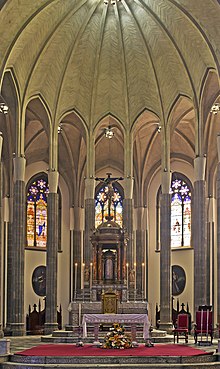
Construction began in 1515 as the second parish church. Its footprint of 80 by 48 feet was of modest proportions. Later renovations, especially in the second half of the 16th century, transformed the single-nave church into a three-nave church with a greatly enlarged chancel by 1590. A few chapels were added to the church in the 17th century. At the end of the 18th century the church consisted of five naves and a bell tower with a clock. When this bell tower had to be replaced at the beginning of the 19th century due to the risk of collapse, it was decided to redesign the entire facade. This transformation coincided with the establishment of the diocese of San Cristóbal de La Laguna . The parish church was declared a cathedral .
As a result of the many alterations and interventions in the basic structure of the building in the 19th century, problems arose with the stability, which led to the church having to be closed and declared a ruin. It was decided to demolish the church, with the exception of most of the facade, and rebuild it in the neo-Gothic style. When the building was rebuilt between 1904 and 1913, the total size of the area was maintained, but in a three-aisled complex. A handling around the chancel was introduced as a new element.
In 2002 the church was closed because of the risk of collapse of the vaults and dome. After the entire roof structure was renewed, the church was reopened on January 31, 2014.
Iglesia de la Inmaculada Concepción de la Virgen María
La Concepción Church is the oldest parish church on the island. The first building was built in 1496/1497. Nothing is left of this building today. In 1515 the Cabildo of La Laguna asked the Cathedral Chapter in Las Palmas de Gran Canaria for permission to rebuild and expand the church. The restoration was slowed down by Alonso Fernández de Lugo , whose interest was directed to promoting the development of the Villa de Abajo and thus the construction of the Remedios Church. After various vicissitudes, the church already basically showed its present appearance in 1558, ie three naves separated by columns. Due to the extensions that were made in the 17th century, a total renovation was necessary, during which the main altar room was also extended between 1714 and 1737. During the 18th century, various parts of the building were renovated or demolished. This was necessary because of the sometimes poor quality of the building materials used. Part of the construction we see today was started towards the end of the 18th century. Today the church is a collection of buildings from different eras that do not have a uniform style. The construction is typical for Canarian churches: house stones on the corners, the window fillings and the portals and large plastered and painted surfaces. Access is through two side portals. The entrance on the north side is from the 16th century and is on the same level as the square. The entrance on the opposite side can be reached via stairs, which are surrounded by gardens. On the north side of the church, the bell tower stands as an independent structure on a square base. It is considered the hallmark of the city of La Laguna. The tower was first erected in 1577, but soon collapsed to be rebuilt in 1630. This construction did not last long either. The tower was built a third and last time in 1694. In the meantime, even in our century, it has undergone many changes. The edges of the tower and the window frames are made of stone. The lower six floors are crowned by an octagonal end. The lower part of the tower, which can be reached from the church through a side chapel, is used as a baptistery and has a Gothic vault. This chapel houses a majolica baptismal font that comes from Seville and was used to baptize the Guanche princes who surrendered to the conquerors in Los Realejos in 1496. The church has been a listed building since 1948.
Traditional festivals in downtown La Laguna
- Semana Santa , the week before Easter
- Corpus Christi, Sunday after Corpus Christi
- Romeria de San Benito, June or July
- Santisimo Cristo de La Laguna, September 14th
traffic
The Los Rodeos airport , also known as Tenerife Norte is called, is located on the western city of La Laguna. In March 1977 he achieved notoriety due to the plane disaster in Tenerife, which left 583 dead. Today the airport is equipped with all the necessary facilities such as ground radar and take-off and landing aids. This airport is primarily used for air traffic with the other islands and with mainland Spain.
The northern motorway TF-5 from Santa Cruz to Realejos leads directly past the city center. With the motorway TF-1 , which leads from Santa Cruz to the south airport, La Laguna is through the connection motorway TF-2 ( Enlace connected). To the east of the city, a bypass connects the city of Tegueste with the northern motorway.
Since 2007, the inner cities of Santa Cruz and La Laguna have been linked again by a tram line.
sons and daughters of the town
- José de Anchieta (1534–1597), Catholic saint, missionary and linguist
- Amaro Pargo (1678-1747), corsair
- Cristóbal Bencomo y Rodríguez (1758–1835), teacher and confessor of Ferdinand VII. Archbishop of Heraclea, General Inquisitor
- Antonio Pereira-Pacheco y Ruiz (1790–1858), clergyman and writer
- Óscar Domínguez (1906–1958), Surrealist painter
- Manuel Antonio Hermoso Rojas (* 1935), regional politician of the autonomous community of Canary Islands
- Ayoze Díaz Díaz (* 1982), football player
- Cristo Reyes (* 1987), darts player
- Ana Guerra (* 1994), singer and candidate for the television program Operación Triunfo 2017
Web links
- Zedler Lexicon entry Laguna , Vol. 16 (1737), Col. 238
- City administration (Spanish)
- History (spanish)
Individual evidence
- ↑ Cifras oficiales de población resultantes de la revisión del Padrón municipal a 1 de enero . Population statistics from the Instituto Nacional de Estadística (population update).
- ↑ La Laguna. La ciudad de los sentidos
- ^ John Mercer: The Canary Islanders - their prehistory conquest and survival . Rex Collings, London 1980, ISBN 0-86036-126-8 , pp. 205 (English).
- ↑ La Peste. El cuarto jinete
- ↑ Instituto Nacional de Estadística español (INE) ( page no longer available , search in web archives ) Info: The link was automatically marked as defective. Please check the link according to the instructions and then remove this notice.
- ↑ German translation: At the time of the reign of Charles II and the tenure of the governor and commander-in-chief of this island and that of La Palma, Lieutenant Colonel Don Agustín del Castillo Ruiz de Vergara and the councilors and captains Don Juan Franco de Castilla y Don Franco the la Guerra.
- ↑ El Papa convierte hoy al Padre Anchieta en santo
- ↑ Prince couple completed a mammoth program in the Canary Islands. Wochenblatt (Canary Islands) , October 26, 2008, accessed on November 11, 2009 .
- ^ Almudena Cruz: De Turín al Cristo lagunero. La Opiñon de Tenerife, April 17, 2014, accessed October 3, 2014 (Spanish).
- ↑ Alejandro Cioranescu: La Laguna - Guia Historicay Monumental . A. Romero SA, La Laguna 1965, p. 65 - 91 (Spanish).
- ^ El obispo Bernardo Alvarez abre la Catedral “al disfrute de todos”. (No longer available online.) DALALAGUNA.COM, January 31, 2014, archived from the original on February 22, 2014 ; Retrieved February 4, 2014 (Spanish). Info: The archive link was inserted automatically and has not yet been checked. Please check the original and archive link according to the instructions and then remove this notice.
swell
- ISTAC (Statistical Department of the Regional Government of the Canary Islands)
- Ana Viña Brito, Mariano Gambín García, Mª Amada Ramos Rodríguez, Leocadia Pérez González: Reales Cédulas, Provisiones y Privilegios de la isla de Tenerife (1496–1531), Oristán y Gociano editors Santa Cruz de Tenerife 2006, ISBN 84-934721-0 -7
- Carlos García: La Ciudad, Relatos históricos y tradicionales de La Laguna , Centro de la cultura popular canaria, La Laguna 1996, ISBN 84-7926-203-6
- Manuel Hernández González: Tenerife, patrimonio historico y cultural , Editoral Rueda Madrid 2002, ISBN 84-7207-134-0








